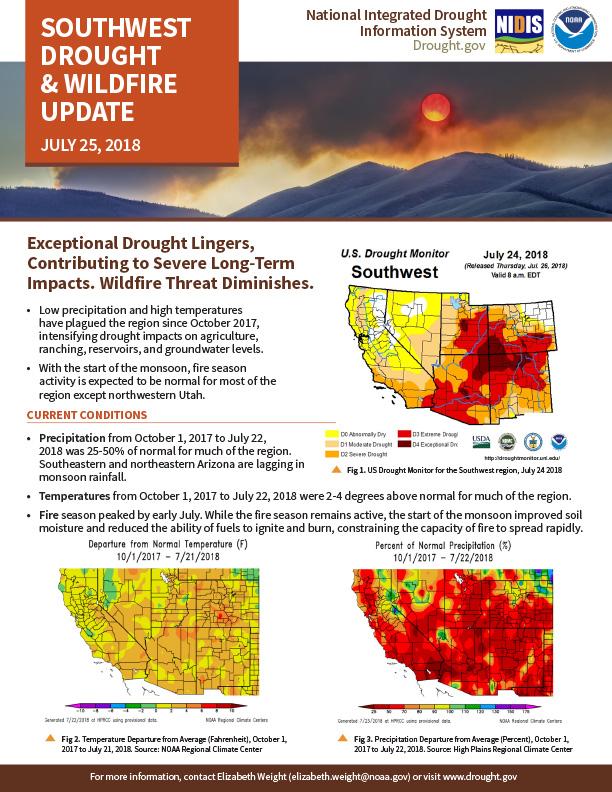For the latest forecasts and critical weather information, visit weather.gov.
Southwest Drought & Wildfire Update - July 25, 2018
Two-page summary of the July 25, 2018 webinar on current Southwest U.S. drought conditions, impacts, and outlook and wildfires.
Exceptional Drought Lingers, Contributing to Severe Long-Term Impacts. Wildfire Threat Diminishes.
- Low precipitation and high temperatures have plagued the region since October 2017, intensifying drought impacts on agriculture, ranching, reservoirs, and groundwater levels.
- With the start of the monsoon, fire season activity is expected to be normal for most of the region except northwestern Utah.
CURRENT CONDITIONS
- Precipitation from October 1, 2017 to July 22, 2018 was 25-50% of normal for much of the region. Southeastern and northeastern Arizona are lagging in monsoon rainfall.
- Temperatures from October 1, 2017 to July 22, 2018 were 2-4 degrees above normal for much of the region.
- Fire season peaked by early July. While the fire season remains active, the start of the monsoon improved soil moisture and reduced the ability of fuels to ignite and burn, constraining the capacity of fire to spread rapidly.
IMPACTS
- Fire: The 454,397 acres burned so far this year is similar to the ten-year average of 445,429 acres. Wildfire burn scars have caused flooding, debris flows, and water quality concerns.
- Drought declarations: The New Mexico Governor issued a drought declaration. Eight counties in Utah issued a drought declaration.
- Reservoirs in Arizona and New Mexico are low: Lake Powell is 52% full; Lake Mead is 37% full; Verde River System is 28% full; Bluewater is 11% full; Elephant Butte and Caballo are 10% full; El Vado is 9% full.
- Other: In southwest Colorado, the price of hay doubled and herds are being culled. Groundwater levels are dropping across Arizona.
OUTLOOK
- Precipitation: Outlooks show enhanced odds for above-normal precipitation in the region, with 65-70% probability of weak-to-moderate El Nino.
- Temperature: Outlooks show enhanced odds for above-normal temperatures in the region.
- Fire: Northwestern Utah shows above-normal wildland fire potential through August. The rest of the region is still in an active fire season but there are no large-scale extreme fire conditions.


